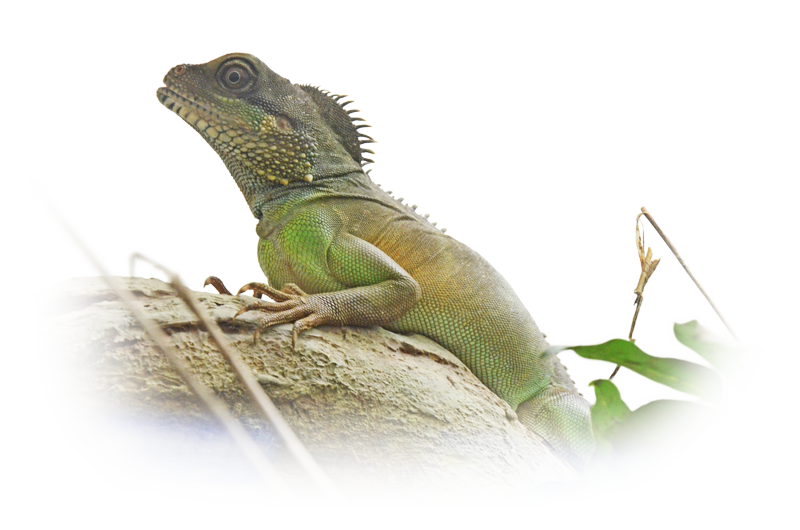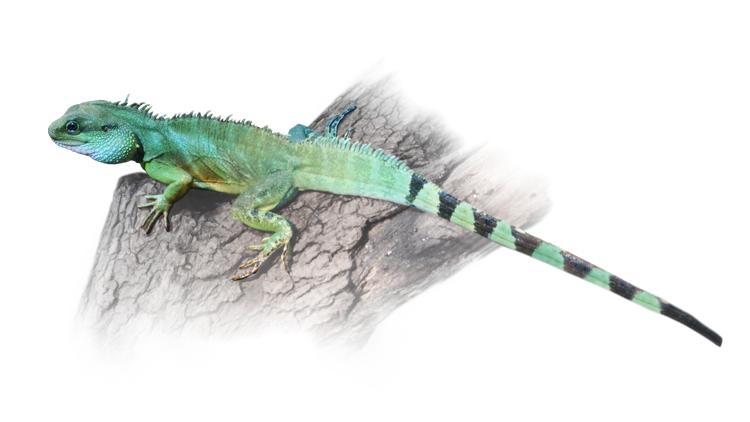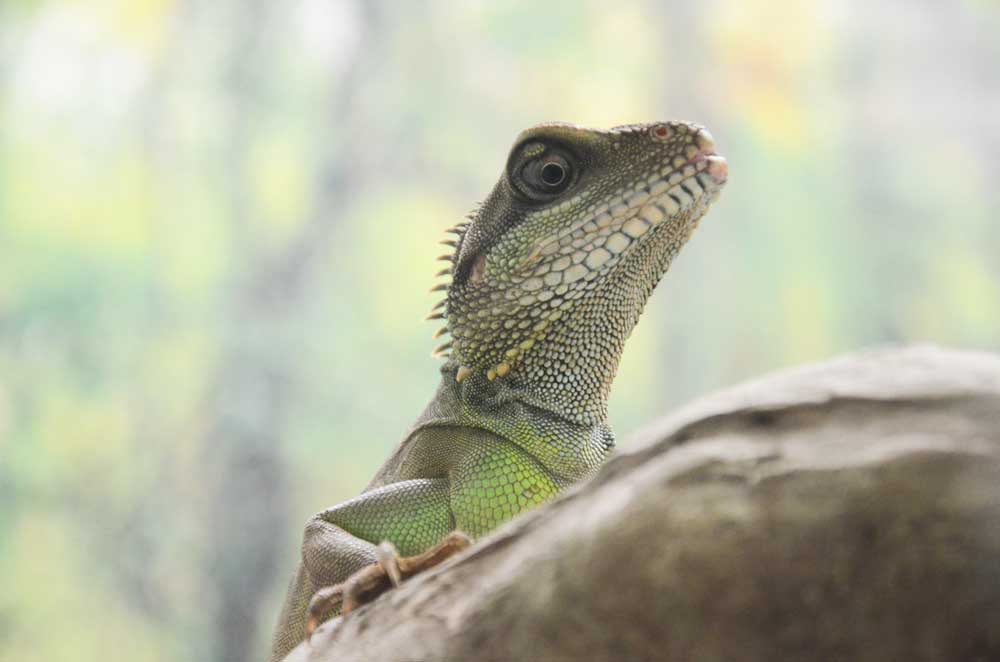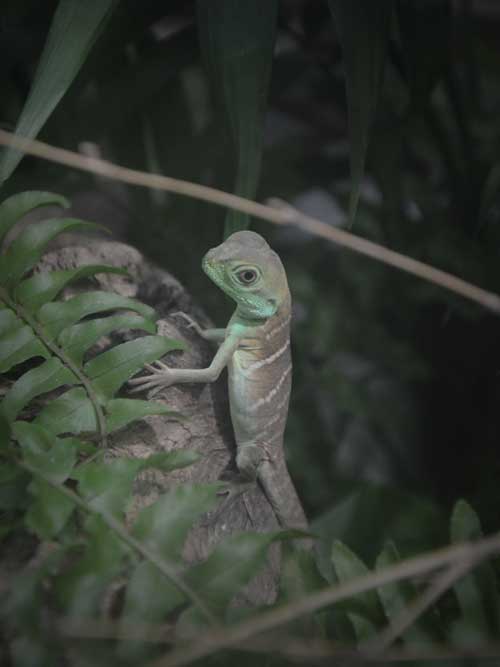

Physignathus cocincinus (Cuvier, 1829)
爬虫類が選んだ道
The Path Chosen by Reptiles
体長は60 – 90cm。タイ、ベトナム、カンボジア、ラオス、ミャンマー、中国南部に分布しています。木登りや泳ぎが得意で、最大で25分間水中に留まることも可能です。体色は緑色で、グリーンイグアナにも似ていますが、ひとまわり小さく、人になつきやすい性格のため、ペットとして飼いやすく人気の爬虫類です。
ワニやトカゲ、ヘビなどの爬虫類には、メスだけで子を産める「単為生殖」が可能な種類も存在しています。2019年に発表された論文によると、本種もメスだけで受精卵を産むことが報告されています。単為生殖は、爬虫類だけでなく、魚類、両生類、鳥類、そしてミツバチやアブラムシなどの昆虫でも確認されています。この生殖方法は、環境の変化によりオスとメスが出会いにくい状況でも、子孫を迅速に残すことが可能です。適切な条件下では、一気に個体数を増やし、その土地での地位を確立させる利点があります。一方で、遺伝的多様性が乏しくなりやすいため、集団の脆弱性が高まり、進化のスピードが遅くなるというデメリットもあります。
このように、単為生殖は過酷な環境下で個体数を維持し、絶滅の危機を回避する手段となりますが、哺乳類にはこの能力は備わっていません。その理由のひとつは、ゲノムインプリンティングにあります。哺乳類は父親と母親からそれぞれ1セットずつ遺伝子を受け継ぎ、遺伝子ごとに「父親優先」や「母親優先」のタグがつけられます。しかし、ゲノムインプリンティングとは、一方の遺伝子だけでは正常に機能しない現象のことです。ゲノムインプリンティングは進化のスピードを速める役目があると言われ、哺乳類が恐竜絶滅以降の時代において陸上を支配してきた一因とも考えられています。
爬虫類は、両生類から進化した動物であり、水中から陸上へ進出する能力を身につけて進化しました。やがて大型化し、恐竜の時代には地球を支配する存在となりました。現在、爬虫類は小型化し、温帯や熱帯の森林、山岳地帯、砂漠などさまざまな環境に適応しています。再び絶滅しないために、現代の爬虫類は恐竜とは異なる進化の道を進んでいるのかもしれません。

They live close to streams and will retreat into the water when in danger.
They range in length from 60 to 90 cm and are found in Thailand, Vietnam, Cambodia, Laos, Myanmar, and southern China. They are skilled tree climbers and swimmers, able to stay underwater for up to 25 minutes. Their green body color resembles that of a green iguana, but they are slightly smaller and sociable, making them a popular pet.
Some reptiles, such as crocodiles, lizards, and snakes, are capable of parthenogenesis, a process in which only females produce offspring. A 2019 paper reported that this species also produces fertilized eggs exclusively through females. Parthenogenesis has been observed not only in reptiles, but also in fish, amphibians, birds, and insects such as honeybees and aphids. This reproductive method allows for rapid reproduction, even in environments where males and females have difficulty meeting. Under the right conditions, it has the advantage of rapidly increasing population numbers and establishing a stronghold in the area. On the other hand, parthenogenesis has the disadvantage of increasing population vulnerability and slowing the rate of evolution because it tends to reduce genetic diversity.
Thus, parthenogenesis is a way to maintain populations in harsh environments and avoid extinction, but mammals lack this ability. One reason for this is genomic imprinting. Mammals inherit one set of genes from their father and one set from their mother, and each gene is tagged as “paternal-dominant” or “maternal-dominant.” However, genomic imprinting is a phenomenon in which one gene alone does not function properly. Genomic imprinting is said to accelerate the speed of evolution and is thought to be one of the reasons why mammals dominated land areas after the extinction of the dinosaurs.
Reptiles evolved from amphibians and acquired the ability to move from water to land. Eventually, they grew larger and dominated the Earth during the age of the dinosaurs. Today, reptiles have become smaller and have adapted to a variety of environments, including temperate and tropical forests, mountainous regions, and deserts. To avoid becoming extinct again, modern reptiles may be taking a different evolutionary path than dinosaurs.
参考文献
“Asian water dragon” Smithsonian’s National Zoo and Conservation Biology Institute. 2025年9月14日閲覧
PRESIDENTオンライン | トカゲ・ヘビ・カメは、オス抜きで子がつくれます | 池田 清彦 (2012年10月28日) 2025年9月14日閲覧
「単為生殖とは何か?その驚くべき事実」(2023年4月10日) チバニアン兼業農学校 2025年9月14日閲覧
石野史敏「ゲノムインプリンティング-世代に刻みこまれる時」季刊生命誌38, JT生命誌研究館 2025年9月14日閲覧

